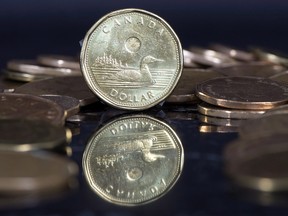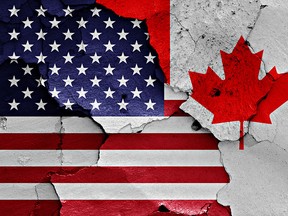Analysts predict that an improving economic backdrop and hawkish central bank mean there is more strength ahead for the Canadian dollar
Article content
The Canadian dollar topped 80 cents against the greenback over the weekend for the first time since January, with analysts predicting that an improving economic backdrop and hawkish central bank mean there is more strength ahead, despite a pullback on Monday.
Karl Schamotta, chief market strategist at Corpay in Toronto, told the Financial Post that a number of factors have been driving the loonie higher in recent weeks, including the ebbing of a safe haven play that saw a rush to the U.S. dollar after Russia invaded Ukraine.
Schamotta added that while the commodities rally and strength in crude oil prices are playing a supporting role, the Bank of Canada’s hawkish messaging has been the star of the sustained rally.
“(Bond) yields are really doing the heavy lifting right now,” Schamotta said in an interview. “So, Friday, deputy Governor Sharon Kozicki really emulated her counterparts at the Fed, and she hinted at bigger rate increases to come and I think this is really, really key.”
Kozicki’s March 25 speech at the Federal Reserve Bank of San Francisco left many market watchers expecting a more aggressive rate-hike path, bringing bond yields up and pulling the Canadian dollar past the 80-cent threshold.
Article content

The deputy governor told conference attendees she expects “the pace and magnitude of interest rate increases and the start of (quantitative tightening) to be active parts of our deliberations at our next decision in April,” hinting that policy-makers could end their government bond-buying program.
“The key word in that is ‘magnitude,’ so (what) markets essentially took out of that (is) we could be looking at a 50-basis point move,” Schamotta said, adding that markets had previously priced in a series of nine or more 25-basis point hikes. “They now expect at least one 50-basis point move in the coming months, perhaps at the April meeting, and so that has driven up yields really across the curve and your Canadian two- and 10-year yields now exceed their U.S. counterparts again.”
Schamotta noted that the energy sector, which plays a less influential role in the overall Canadian economy than it once did, is a smaller factor in the loonie’s recent move, as it continues to shed its former “petrocurrency” title.
“The first thing to kind of emphasize is that the energy sector has shrunk in terms of its relevance to the overall Canadian economy,” Schamotta said, adding that consumer spending and investments in housing have played a larger role. “What has happened here is a shift away from market perceptions as the Saudi Arabia of the North…. But we are sort of the housing bubble of the North now, and so I think to some extent, a lot of the trading activity that we see has to do with what investors think is going to happen to lending conditions in Canada to real estate prices and therefore to consumer consumption.”
Earl Davis, the head of fixed income and money markets at the Bank of Montreal, said that despite some short-term volatility due to a pullback in oil prices, he expects that the loonie will continue its hot streak this year.
“You have an economy that’s basically at full employment … and you have you have the backing of the commodity-based economy, so you’ll have cash flows coming in,” Davis said. “So, there’s a lot of things supportive of a stronger dollar.”
Davis also dismissed any potential headwind on the horizon as being more like “breezes,” the biggest of which would be the amount of spending involved in the upcoming federal budget.
Article content
-

How Ukraine embraced cryptocurrencies in response to war
-

Open banking presents ‘an opportunity, not a problem’ for credit unions, Meridian CEO says
-

How the push to modernize Canada’s payment systems went off the rails
“If there were a time this year when we see a pullback, it might be after the budget,” Davis said. “So, if there’s more spending than expected, that’s the only thing that could pull it back: fiscal spending, or lack of fiscal discipline.”
Schamotta is also predicting more growth with the loonie in the short term, anticipating that it will gain a few more cents on the back of elevated commodities prices and greater growth compared to global currencies outside of North America. But he also imparted a cautionary outlook for the dollar if Canadian household debt continues to put a strain on the economy.
“I always think of (the Canadian dollar) as Icarus, if it gets too close to the sun, the wings will melt,” Schamotta said. “The Canadian dollar is very likely to be limited in the coming months, mainly by the fact that as yields rise, that is going to put additional stress on over-indebted Canadian households.”
“At some point, the narrative is going to be about whether Canadian households can withstand higher rates to the same degree that their American counterparts can,” he said. “And so, at some point, I wouldn’t be too surprised to see the yield curve invert and for the loonie to move lower.”
The loonie closed Monday just shy of the 80-cent mark, falling nearly half a per cent.
• Email: shughes@postmedia.com | Twitter: StephHughes95
Loonie’s push past 80 cents may have legs, analysts say, but commodity prices aren’t the driving factor
2022-03-29 11:00:27





